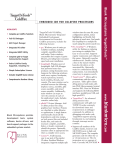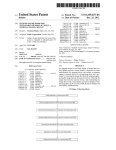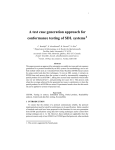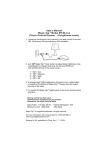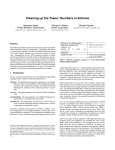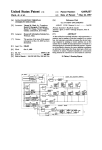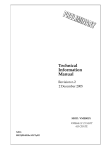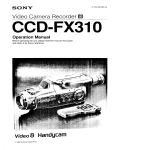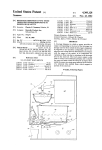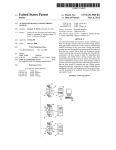Download Motherboard
Transcript
US0071 l l 160Bl (12) United States Patent Henniger et al. (54) (10) Patent N0.: (45) Date of Patent: METHOD AND APPARATUS FOR USING A DEVELOPMENT PORT FOR BOOT UP 6,003,130 A * 6,105,136 A * 6,161,177 (75) Inventors: Mick Henniger, Austin, TX (US); (US); Ming Chi Chen, Union City, CA (US); Ramesh Srinivasan, Santa Clara, CA (US); Severin Baer, Cupertino, CA (US); Sanjoy Dey, Fremont, CA (US); Smita Kiran Rane, Sunnyvale, CA (Us) (73) Assignee: Cisco Technology, Inc., San Jose, CA (Us) Notice: Subject to any disclaimer, the term of this patent is extended or adjusted under 35 USC 154(b) by 0 days. (22) (51) Int. Cl. 12/2000 6,449,732 B1 * 9/2002 (52) (58) 370/395.1; 361/724, 725; 709/200 See application ?le for complete search history. OTHER PUBLICATIONS Code TAP® for the Motorola® MPC8XX; Apr. 1997; cover sheet, Chapter 14OvervieW, pp. 1-7 through 1-8 and Chapter 44Connecting to the Target, pp. 4-1 through 4-11. Motorola MPC860 User’s Manual; Figure 1-1.MPC860 Block Diagram, Section 4iReset pp. 4-1 through 4-11 and Support Development pp. 18-20 through 18-40. * cited by examiner Primary ExamineriJeiTrey Gaf?n Assistant ExamineriHassan Mahmoudi (74) Attorney, Agent, or Firm4Campbell Stephenson ABSTRACT mation can include information used for con?guring a port, other than the development port, and/or for con?guring a memory controller, such as for a daughterboard DRAM. Use of the Debug port makes it possible to reduce or eliminate the need for storing boot-up code or con?guration informa tion on a daughterboard ROM, or other non-volatile memory, thus reducing cost and space requirements, poWer consumption and the like. References Cited U.S. PATENT DOCUMENTS Tehranian et al. 713/2 ........ .. 714/12 con?guration information from a motherboard for use in 713/201, 400; 714/25, 30, 12; 710/302; 3/1999 Rasmussen et al. . . . . .. boot-up. In various aspects, the code or con?guration infor US. Cl. ......................... .. 713/2; 713/200; 709/200 Field of Classi?cation Search .................. .. 713/2, 5,878,248 A * 713/201 . . . . . . . . . . . . The development port or Debug port of a microprocessor on an intelligent daughterboard is used for downloading code or (2006.01) (2006.01) (56) Anderson Applied Microsystems Corporation; Emulator Installation Guide; (57) Feb. 7, 2000 G06F 9/44 G06F 15/16 Anderson .................... .. 713/2 Ascolese LLP (21) Appl. N0.: 09/499,598 Filed: Sep. 19, 2006 8/2000 Cromer et a1. . * Kelvin Shih-Tai Liu, Culpertino, CA A 12/1999 US 7,111,160 B1 14 Claims, 4 Drawing Sheets ........ .. 709/200 Motherboard /______ U.S. Patent 2896 Sep. 19, 2006 m1 n 31; _1 m Sheet 2 of4 lzéoQ1 __ T 2 E US 7,111,160 B1 3% é t d c $12 @EE 2896 6D~m: 3%E E 6E5 12E%5 NNF 2896 m1 28 :? U.S. Patent Sep. 19, 2006 m “ /./. P_m m m m u u n P _ mml-mm Sheet 3 of4 FD”rrwGT 2Aw m x" m 6 2"nH 2mm m ”ME mm :n:u.ow. _ 0 _ US 7,111,160 B1 /\ Test/Debug Reset \ 412b / 414 Transfer memo rly controller configuration informatjon from motherboard to deve opment port on aughterboard mlcroprocessor Con?gure memory controller / 436 \ 4 rtbeor8.0mwmm h g r e p r 0 8 % ‘aLlsrm o0 anm.|gmtrnlo a00 .nr9 mmcnmdeD Meh mme .ld nV86 gI"pI \we 00.| 416 Tommne‘mm.nwmmmD WVMea ?m\_0S4mm4 m mtuo 6 1 (Soft) Reset daughterboard microprocessor 452 FIG. 4 \ \ Em“ te image U.S. Patent 28 6 / E826: / Sheet 4 of4 US 7,111,160 B1 vm / mi‘11 0.2 / 11 9m 28 62 Sep. 19, 2006 28 59 um65% £852 .mmQDN ESQ .3mQPN 35/ 8% 3L" m 31L" _ _ ? ll m1 .02 52 a US 7,111,160 B1 1 2 METHOD AND APPARATUS FOR USING A DEVELOPMENT PORT FOR BOOT UP cessor (Which is a port that is normally inactive or not used during poWer-up, boot-up, reset or during normal operation) is used to facilitate one or more of the boot-up procedures, such as accessing or storing boot-up code, con?guration information and the like, originating on (or received from) the motherboard (or other component of the electronic device). In one embodiment, the development port is used only for doWnloading or accessing the minimum amount of boot code (or the like) needed or useful for initially booting The present invention is related to employing a develop ment port of a microprocessor for boot procedures and in particular to reduce or avoid the need for relying on a read only memory (ROM) or similar device for boot up. BACKGROUND INFORMATION or con?guring the daughterboard components. In one It is common for microprocessor-based electronic equip embodiment, initial code doWnloaded, via the development ment to include tWo or more interconnected printed circuit port, includes code as needed for con?guring a memory boards, often including a main circuit board having the main controller or microprocessor (often termed the “mother controller and/or other devices permitting operation of a DRAM. Thereafter, additional operating system or other code is imported into daughterboard memory via more conventional routes. In another embodiment, the develop ment port is used for doWnloading, onto the daughterboard, some or all of the operating system (or the so-called board”) and one or more connected “daughterboards”. In many electronic devices, some or all of the daughterboards, may, themselves, be “intelligent”, i.e., may have their oWn programmable controllers, typically microprocessors. When electronic devices of these types are operated, upon initial poWer-up (or, in some cases, upon resetting the “image”) used for normal operation of the daughterboard. 20 BRIEF DESCRIPTION OF THE DRAWINGS microprocessors) some or all devices on the boards need to access and/or execute certain microcode or other code or con?guration information. Some or all of this code or information may include What is commonly called “boot-up code”. Because such boot-up code must be available, (eg FIGS. 1A and ID are a How diagram and a block diagram, respectively, depicting procedures and components for boot 25 upon poWer-up), it is often stored in a read only memory FIGS. 1B and 1E are a How diagram and a block diagram, (ROM) device mounted on the same board Where the microprocessor is mounted. Although ROM components are commonly provided for this purpose, it is, at least theoreti cally, possible to use any type of non-volatile memory, such respectively, depicting procedures and components for boot 30 respectively, depicting procedures and components for boot In many situations, providing or mounting a separate ROM (or other non-volatile memory) component on an 35 up With respect to an intelligent daughter card according to one previous approach; FIG. 2 is a block and How diagram depicting components and procedures using a Debug port for testing or Debug purposes according to previous approaches; a daughterboard occupies surface area on the board Which is often needed for accommodating other components or cir cuitry (particularly since many daughterboards have rela tively small surface area). Furthermore, the ROM compo nents themselves undesirably add to the cost of the up With respect to an intelligent daughter card according to one previous approach; FIGS. 1C, and IF are a How diagram and a block diagram, as ?ash memory, SRAM and the like. intelligent daughterboard is a non-optimal approach to pro viding boot-up code. The mounting of a ROM component on up With respect to an intelligent daughter card according to one previous approach; FIGS. 3A, B and C are block diagrams depicting proce 40 daughterboard and the cost of mounting such ROM devices undesirably adds to the cost of board fabrication. ROM devices undesirably consume poWer. Furthermore, ROM dures for daughterboard boot-up according to embodiments of the present invention; and FIG. 4 is a How chart depicting steps in a boot-up procedure of an intelligent daughterboard according to an embodiment of the present invention. devices and similar memory devices may be cumbersome or impossible to reprogram, e.g., to accommodate upgrades and the like. Accordingly, it Would be useful to provide a system, method and apparatus for use in booting up an intelligent daughterboard While eliminating or reducing the need for DETAILED DESCRIPTION OF THE PREFERRED EMBODIMENT Before describing aspects of the present invention, certain previously-used approaches Will be described. As depicted mounting a ROM or other nonvolatile memory on the daughterboard. 50 Cost is often a consideration in designing and implement ing electronic devices and, although there are advantages (noted above) to avoiding the need for mounting nonvolatile memory on a daughterboard, the cost for such an approach can be a signi?cant issue. Accordingly, it Would be useful to provide a system, method and apparatus to reduce or avoid 112, an intelligent daughterboard 114 (i.e. having a micro processor or similar controller 116), Which is coupled to a motherboard 118 (typically via an edge connector 122) Will 55 have a microprocessor 116 Which receives boot code 124 from a non-volatile memory such as a ROM 126 mounted on the daughterboard. In a typical situation, the daughterboard the need for mounting nonvolatile memory on an intelligent daughterboard in Which at least some of the components or processor 116 includes a serial or other port 128 coupled to a bus 132. HoWever, in typical previous devices, it is features involved are components and features Which are already present, eg for another purpose. in FIGS. 1A and 1D, according to at least some previous approaches, upon poWer up (or reset) of an electronic device 60 necessary to use the boot code 124 to con?gure the serial port 128 before receiving information from the motherboard SUMMARY OF THE INVENTION 118 over the bus 132. For this reason, in the con?guration depicted in FIG. 1D, it is impossible to doWnload the boot The present invention includes the recognition of the existence, nature and/or source of problems in previous approaches, including as described herein. According to one aspect, the development port of a daughterboard micropro code 124 from the motherboard 118 over the bus 132, since 65 the daughterboard 128 cannot be con?gured until after the boot code 124 has been accessed. As noted above, the need for providing a nonvolatile memory 1.26 mounted on the US 7,111,160 B1 3 4 daughterboard 114 undesirably increases costs, occupies to reduce or avoid the need for mounting a ROM component board surface area, consumes power, and may make it (or other non-volatile memory component) on the daugh cumbersome or impossible to provide programming terboard. upgrades. Many types of microprocessors provide a development port or debug port. One example is the development port provided in the Motorola MPC860 microprocessor and described, e.g., in MPC860 PoWer QuiccTM user’s manual, especially at pages 4*1 through 4*12 and 18*22, 18410, incorporated herein by reference. Regardless of What it may After the boot code 124 is provided from the ROM 126, the port 128 can be con?gured thus permitting the operating system or “image” to be loaded 134 (FIG. 1A), typically from the ROM 126 (FIG. 1D)(e.g. a PROM or from a ?ash memory). As described beloW, in other con?gurations, the be called in other contexts, as used herein, a development port or Debug port of a microprocessor is a port Which does not need con?guration, folloWing a poWer-up or (soft) reset, in order to load or receive data provided at the port. In the image can be doWnloaded through the interface betWeen the host and the daughtercard. Thereafter, the microprocessor 116 can be reset and the operating system or image can execute 136 (FIG. 1A). present context, a soft reset Will cause the image to start In the approach of FIGS. 1B and 1E, a daughterboard Which contains a memory other than (or in addition to) a executing at the reset vector in DRAM. In the example of the MPC860, the development port is a dedicated serial port Which does not need any of the regular system interfaces. In dynamic random access memory (DRAM) storage device, such as a static random access memory device (SRAM) 138. the example of the MPC860, the development port provides In the approach of FIG. 1B, folloWing poWer up or reset 112 the processor 142 (FIG. IE) on the motherboard (or “host”) 118 provides ?rmWare or microcode image for doWnloading 20 144, e.g., via a serial or other bus 146 to the non-DRAM cessor is inactive or not used during normal operation of the electronic device and also is typically inactive or not used during poWer-up or boot-up procedures in an electronic storage device 138 on the daughter card 114 (via an interface betWeen the host and the card). Following the image doWn load, the processor on the daughter card 114 is reset 148 (FIG. 1B), after Which it executes the image 152. Unfortunately, the con?guration depicted in FIGS. 1B and 25 DRAM 154, for proper operation, needs to be coupled to or and the like. In a typical use, a Debug port 212 (FIG. 2) of a microprocessor 214 is connected, via a ribbon connector, 30 Applied Microsystems Corporation, and described, for 35 gate array or the like) or, in some cases, may be built-in as part of the microprocessor 116. In either case, hoWever, the memory controller 156 must be typically con?gured before it can control the DRAM 154. Accordingly, in the con?gu Debug port during normal operation of an electronic device by an end user. When an emulator 218 is coupled to a Debug port 212, it is possible to use the emulator 218 to load data 1C), microcode or con?guration information 158 (FIG. 1F) is provided to (or accessed by) the microprocessor 116 from cost, occupying surface area, consuming poWer and making it impossible or cumbersome to provide updates. In the approach of FIGS. 1C and IF, after the memory controller has been con?gured, the image or operating system can be doWnloaded, eg from the motherboard 144 for storage 164 in the DRAM 154. Thereafter, the microprocessor 116 is reset 166 (FIG. 1C) and the image stored in the DRAM 154 to the Debug port 212 and, if desired, it Would be possible to use an emulator 218 to doWnload boot code 222 to the Debug port 212. 45 50 55 interface to the motherboard 316, eg through an edge 60 connector 3281). In one embodiment, on the daughterboard 318, the bus 326 comprises a plurality of traces or leads formed on the surface of the printed circuit board 318 in a manner that Will understood by those of skill in the art. With respect to the motherboard 316, in one embodiment, a serial peripheral device connection is used, at least during boot up, processors Which is provided for testing or debugging pur referred to as a “Debug port”) can play a role in boot-up of an intelligent daughterboard, in particular, in such a Way as controller con?guration information, is doWnloaded 314 (FIG. 3A) from a motherboard 316 to a coupled daughter board 318 through the development port 322 of the daugh terboard microprocessor 324. In the embodiment depicted in FIG. 3A, a bus (or other) communication line 326 is pro vided betWeen the development port 322 and a connection or nition that a component or feature of many types of micro poses, namely the development port (DP) (sometimes (FIG. 4) initial boot-up code (or con?guration information), Which can, in at least one embodiment, include memory memory component or device 126 (FIGS. 1D and F), 138 (FIG. 1E) (such as a PROM or an SRAM) on the daugh terboard 114. SRAMs and similar devices are generally disadvantagous at least because of their relatively high cost, and poWer and space requirements. One aspect of the present invention involves the recog One aspect of the present invention involves using the Debug port of a daughterboard microprocessor during nor mal use by an end user and, in particular during normal boot-up, such as folloWing poWer-on or reset. As depicted in FIGS. 3AiC and 4, folloWing poWer-up or reset 412a,b, is executed 168. Thus, as can be seen from FIGS. 1A through F, in the depicted previous approaches, it Was typically necessary to provide some type of non-DRAM, typically non-volatile, example, in “Emulator Installation Guide, Code TAP for the Motorola MPC8XX”, particularly pages 1*7, 21*8 and 4il24ill, incorporated herein by reference. An emulator 218 is typically used for testing the above unit, or other development purposes, and is typically not coupled to a ration of FIGS. 1C and IF, upon poWer up or reset 112 (FIG. a ROM 126 (or other nonvolatile memory) and then pro vided 162 to the memory controller 156. Thus, in the embodiment of FIG. 1C, a ROM 126 is used, increasing cable or the like, 216 to an external emulator device 218. An example of an external emulator device of a type that can be used in connection With the MPC860, for example, is that sold under the trade name Code TAPTM, available from controlled by a memory controller 156 (FIG. 1F) (eg to provide it With timing information and the like). A memory controller 156 can be provided externally in hardWare (eg using a programmable logic device or a ?eld programmable device. Instead, the development port is generally used during product design or development, testing, debugging IE is not feasible When the target device on the daughter card (for storing the image) is DRAM 154 (as depicted in FIG. 1F). In the approach depicted in FIGS. 1C and IF, the a full duplex serial interface. The physical connections for using the development port in the MPC860 include a 10-pin connector. Typically, the development port of a micropro 65 for providing a path to doWnload information codes, con ?gurations and the like stored on the motherboard (eg in a memory device mounted on or coupled to the motherboard). US 7,111,160 B1 5 6 In the embodiment depicted in FIGS. 3AiC, the memory controller 332 is provided as a component of the micropro cessor 324, although, as noted above, it is also possible to using it for con?guring a memory controller. The present invention can be used in any of a plurality of different types or categories of electronic devices, including personal com puters, Work stations, netWork devices such as routers, sWitches, bridges, hubs and the like, telecommunications use the present invention in con?gurations in Which a memory controller is provided as an external device. The information Which Was doWnloaded 414 is used to con?gure 416 the memory controller 322. Once the memory controller devices or components and the like. retically, operable. In one embodiment (FIG. 3C), folloWing con?guration of the memory controller 332, further coding The present invention, in various embodiments, includes components, methods, processes, systems and/or apparatus substantially as depicted and described herein, including various embodiments, subcombinations, and subsets or softWare, such as an operating system or “image” is thereof. Those of skill in the art Will understand hoW to make 332 has been con?gured, the DRAM 334 is, at least theo doWnloaded 336 (step 436) through the development port and use the present invention after understanding the present 322 for transfer 338 to the DRAM 334. In another embodi ment (FIG. 3B), image or other code can be transferred 342 from the motherboard and provided 446 to the DRAM 334 disclosure. The present invention, in various embodiments, includes providing devices and processes in the absence of items not depicted and/or described herein or in various by using a system bus 346 i.e. Without using the develop embodiments hereof, including in the absence of such items ment port 322 for the transfer of the image or the operating system. In any case, after the operating system or image has been stored in the DRAM 334, the daughterboard micro processor can be (soft) reset 448 and the image can be executed 452. as may have been used in previous devices or processes, eg for improving performance, achieving ease and/or reducing 20 As can be seen from FIGS. 3A£, use of the development port 322, as described, makes it possible to provide for con?guration or boot up of an intelligent daughterboard in the absence of a need for using a ROM or other non-volatile 25 memory mounted on the daughterboard. The depicted cost of implementation. The present invention includes items Which are novel, and terminology adapted from pre vious and/or analogous technologies, for convenience in describing novel items or processes, do not necessarily retain all aspects of conventional usage of such terminology. The foregoing discussion of the invention has been pre sented for purposes of illustration and description. The foregoing is not intended to limit the invention to the form or forms disclosed herein. Although the description of the embodiments include a DRAM mounted on the daughter board, but typically, a DRAM Would be provided for use invention has included description of one or more embodi during non-boot up general operation of the daughterboard ments and certain variations and modi?cations, other varia tions and modi?cations are Within the scope of the invention, eg as may be Within the skill and knoWledge of those in the and accordingly does not represent an additional cost, con sumption of poWer or surface area and the like (compared to the poWer, surface area and cost needed for non-boot-up 30 art, after understanding the present disclosure. It is intended operation). As noted above, a Debug port is commonly provided on microprocessors (for other purposes) and thus this component or feature used during embodiments of the to obtain rights Which include alternative embodiments to the extent permitted, including alternate, interchangeable 35 present invention also is a component or feature Which is already present for other purposes and thus is compatible With providing embodiments of the present invention With out the need to design or provide additional components. In at least some embodiments, communication of code or data 40 from the motherboard to the daughterboard development port is performed using the motherboard’s serial peripheral device connection, coupling or pathWay, also already present (on the motherboard) for another purpose, thus in assisting in avoiding the need for incurring additional design or component costs in order to implement embodiments of the present invention. In light of the above description a number of advantages of the present invention can be seen. The present invention makes it feasible to achieve con?guration and/or boot up of and/or equivalent structures, functions, ranges or steps to those claimed, Whether or not such alternate, interchange able and/or equivalent structures, functions, ranges or steps are disclosed herein, and Without intending to publicly dedicate any patentable subject matter. What is claimed is: 1. A method of booting up a system, Wherein the system comprises a motherboard coupled to daughterboard, Wherein the daughterboard comprises a microprocessor, a system bus, a random access memory that stores a copy of an 45 operating system, and a second bus, Wherein the micropro cessor comprises a development port coupled to the second bus, Wherein the microprocessor comprises a memory con troller, Wherein the memory controller is coupled to the random access memory via the system bus, the method 50 comprising: transmitting memory controller con?guration information an intelligent daughterboard While reducing or eliminating the need for using and/or mounting a ROM or other non from said motherboard to said memory controller via volatile memory device on the daughterboard. The present invention accordingly can reduce the cost, consumption of surface area and/or consumption of poWer on the daughter board, needed for boot up or con?guration purposes, e.g. the development port and the second bus, in response to a poWer-on or reset of said system; and 55 providing additional surface area Which can be used mount ing other circuitry or components. The present invention the memory controller con?guration information via the development port and in response to the poWer-on effectively makes use of one or more features or components Which are provided or used for other purposes, thus making it possible to implement at least some embodiment of the the memory controller reading some or all of the operat ing system copy stored in the random access memory via the system bus after the memory controller receives 60 or reset of said system. present invention Without undue requirements for adding 2. The method of claim 1 transmitting the copy of the operating system from the motherboard to the random additional components to an electronic device. access memory for storage therein. The number of variations and modi?cations of the inven tion can be used. It is possible to use some aspects of the invention Without using others. It is possible to use the development port during daughterboard boot up Without 65 3. The method of claim 1 Wherein the development port comprises a full duplex serial interface. 4. The method of claim 1 further comprising transmitting the operating system copy from the motherboard to the US 7,111,160 B1 7 8 random access memory for storage therein via the develop ment port, after the memory controller receives the memory 9. The apparatus of claim 7 Wherein the development port is con?gured to transfer the con?guration information auto controller con?guration information via the development matically, in response to a poWer up or a reset of the port and in response to the poWer-on or reset of said system. 5. The method of claim 4 Wherein the memory controller con?guration information is transferred to the memory con apparatus. 10. The apparatus of claim 9 Wherein the memory con troller is con?gured to read some or all of the operating system copy stored in the random access memory after the troller from a memory device on said motherboard. 6. An apparatus comprising: memory controller receives the con?guration information a ?rst printed circuit board; a processor mounted to the ?rst printed circuit board, Wherein the processor comprises a development port and in response to the poWer up or the reset of the apparatus. 11. The apparatus of claim 10 Wherein the development port comprises a full duplex serial interface. 12. The apparatus of claim 6 Wherein the second bus and a memory controller; a system bus formed on the ?rst printed circuit board and coupled to the memory controller; comprises a serial data bus. a second bus formed on the ?rst printed circuit board and coupled to the development port; 13. An apparatus comprising: a random access memory mounted on the ?rst printed a ?rst printed circuit board coupled to a second printed circuit board and coupled to the memory controller via the system bus, Wherein the random access memory stores a copy of an operating system; circuit board; 20 a processor mounted to the ?rst printed circuit board, Wherein the development port is con?gured to transfer con?guration information to the memory controller; Wherein the processor comprises a development port Wherein the memory controller is con?gured to read some or all of the operating system copy stored in the random access memory via the system bus after the memory a random access memory mounted on the ?rst printed circuit board and con?gured to store a copy of an and a memory controller; 25 controller receives the con?guration information via the development port. 7. The apparatus of claim 6 further comprising: a second printed circuit board; a ?rst data storage device mounted on the second printed controller; 30 circuit board, Wherein the ?rst data storage device of the processor. 8. The apparatus of claim 7 Wherein the development port receives data from an emulator device external to the pro cessor When the development port is coupled to the emulator device. a second bus coupled to the development port, Wherein the second bus is formed on the ?rst printed circuit board; stores the con?guration information; a coupler, coupling the ?rst printed circuit board to the second printed circuit board, de?ning at least a ?rst data communication path from said second printed circuit board to said ?rst printed circuit board; Wherein the con?guration information can be transmitted from the ?rst storage device, over the ?rst communi cation path, said second bus, to said development port operating system; a system bus formed on the ?rst printed circuit board and coupled to the random access memory and the memory 35 means for doWnloading memory controller con?guration information from said second printed circuit board to said memory controller via the development port and the second bus, in response to a poWer on or reset of said apparatus. 14. The apparatus of claim 13 Wherein the development port receives data from an emulator device external to the processor When the development port is coupled to the emulator device.









